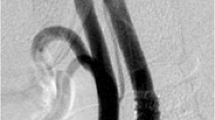Abstract
We developed a new filter-type distal protection guide wire, Filtrap, that uses a polyurethane filter with 1834 100-μm micropores covering the distal half of a spindle-shaped spiral Ni–Ti basket. The basket is 5 mm in diameter, self-expandable, and is mounted at the distal end of the system. This study aimed to assess the usefulness and safety of Filtrap during percutaneous coronary intervention (PCI). Early angiographic and in-hospital outcomes were reviewed in 14 patients, including 9 acute coronary syndrome patients, treated with Filtrap during PCI. All lesions were located in native coronary arteries but one was located in a saphenous vein graft. The Filtrap was successfully delivered and deployed distal to the lesion in 13 of 14 patients (93%). All PCI procedures including stent implantation were successfully completed except for 2 AMI patients, who ended up with Thrombolysis in Myocardial Infarction (TIMI) 2 coronary flow. One of these 2 patients had a distal embolization which occurred after thrombectomy before Filtrap insertion. The mean time of device insertion was 9.4 ± 3.2 min. Five patients showed transient no-reflow that was completely restored immediately with removal of the device. Embolic debris was entrapped in 8 (62%) of these cases. All patients were free from in-hospital events except for one patient with a large anterior acute myocardial infarction who received an emergency surgery due to a free wall cardiac rupture. These results suggest that the Filtrap is a practical and safe device for embolic protection during PCI.




Similar content being viewed by others
References
Grube E, Gerckens U, Yeung AC, Rowold S, Kirchhof N, Sedgewick J, et al. Prevention of distal embolization during coronary angioplasty in saphenous vein grafts and native vessels using porous filter protection. Circulation. 2001;104:2436–41.
Stone GW, Rogers C, Hermiller J, Feldman R, Hall P, Haber R, et al. Randomized comparison of distal protection with a filter-based catheter and a balloon occlusion and aspiration system during percutaneous intervention of diseased saphenous vein aorto-coronary bypass grafts. Circulation. 2003;108:548–53.
Baim DS, Wahr D, George B, Leon MB, Greenberg J, Cutlip DE, et al. Randomized trial of a distal embolic protection device during percutaneous intervention of saphenous vein aorto-coronary bypass grafts. Circulation. 2002;105:1285–90.
Reimers B, Corvaja N, Moshiri S, Saccà S, Albiero R, Di Mario C, et al. Cerebral protection with filter devices during carotid artery stenting. Circulation. 2001;104:12–5.
Yadav JS, Wholey MH, Kuntz RE, Fayad P, Katzen BT, Mishkel GJ, et al. Protected carotid-artery stenting versus endarterectomy in high-risk patients. N Engl J Med. 2004;351:150–1493.
Hong MK, Mehran R, Dangas G, Mintz G, Lansky AJ, Pichard AD, et al. Creatine kinase-MB enzyme elevation following successful saphenous vein graft intervention is associated with late mortality. Circulation. 1999;100:2400–5.
Tardiff BE, Califf RM, Tcheng JE, Lincoff AM, Sigmon KN, Harrington RA, et al. Clinical outcomes after detection of elevated cardiac enzymes in patients undergoing percutaneous intervention. IMPACT-II Investigators. Integrilin (eptifibatide) to Minimize Platelet Aggregation and Coronary Thrombosis-II. J Am Coll Cardiol. 1999;33:88–96.
Saucedo JF, Mehran R, Dangas G, Hong MK, Lansky A, Kent KM, et al. Long-term clinical events following creatine kinase–myocardial band isoenzyme elevation after successful coronary stenting. J Am Coll Cardiol. 2000;35:1134–41.
Fujii K, Carlier SG, Mintz GS, Kobayashi Y, Jacoboff D, Nierenberg H, et al. Creatine kinase-MB enzyme elevation and long-term clinical events after successful coronary stenting in lesions with ruptured plaque. Am J Cardiol. 2005;95:355–9.
Stone GW, Webb J, Cox DA, Brodie BR, Qureshi M, Kalynych A, et al. Distal microcirculatory protection during percutaneous coronary intervention in acute ST-segment elevation myocardial infarction: a randomized controlled trial. JAMA. 2005;293:1063–72.
Muramatsu T, Kozuma K, Tsukahara R, Ito Y, Fujita N, Suwa S, et al. Comparison of myocardial perfusion by distal protection before and after primary stenting for acute myocardial infarction: angiographic and clinical results of a randomized controlled trial. Catheter Cardiovasc Interv. 2007;70:677–82.
Kaltoft A, Kelbæk H, Kløvgaard L, Terkelsen CJ, Clemmensen P, Helqvist S, Lassen JF, Thuesen L. Increased rate of stent thrombosis and target lesion revascularization after filter protection in primary percutaneous coronary intervention for ST-segment elevation myocardial infarction: 15-month follow-up of the DEDICATION (Drug Elution and Distal Protection in ST Elevation Myocardial Infarction) trial. J Am Coll Cardiol. 2010;55:867–71.
Angelini A, Rubartelli P, Mistrorigo F, Barbera MD, Abbadessa F, Vischi M, et al. Distal protection with a filter device during coronary stenting in patients with stable and unstable angina. Circulation. 2004;110:515–21.
Porto I, Choudhury RP, Pillay P, Burzotta F, Trani C, Niccoli G, et al. Filter no reflow during percutaneous coronary interventions using the Filterwire distal protection device. Int J Cardiol. 2006;109:53–8.
Rogers C, Huynh R, Seifert PA, Chevalier B, Schofer J, Edelman ER, et al. Embolic protection with filtering or occlusion balloons during saphenous vein graft stenting retrieves identical volumes and sizes of particulate debris. Circulation. 2004;109:1735–40.
Ikari Y, Sakurada M, Kozuma K, Kawano S, Katsuki T, Kimura K, et al. Upfront thrombus aspiration in primary coronary intervention for patients with ST-segment elevation acute myocardial infarction: report of the VAMPIRE (VAcuuM asPIration thrombus REmoval) trial. JACC Cardiovasc Interv. 2008;1:424–31.
Vlaar PJ, Svilaas T, van der Horst IC, Diercks GFH, Fokkema ML, de Smet BJGL, et al. Cardiac death and reinfarction after 1 year in the Thrombus Aspiration during Percutaneous coronary intervention in Acute myocardial infarction Study (TAPAS): a 1-year follow-up study. Lancet. 2008;371:1915–20.
Acknowledgments
Nipro provided financial support for the histopathologic analyses.
Conflict of interest
Dr. Isshiki has received royalties, consulting fees, and honoraria from Nipro and holds Nipro company stock. Dr. Kozuma has received consulting fees and honoraria from Nipro. The other authors report no conflicts of interest.
Author information
Authors and Affiliations
Corresponding author
Rights and permissions
About this article
Cite this article
Isshiki, T., Kozuma, K., Kyono, H. et al. Initial clinical experience with distal embolic protection using “Filtrap”, a novel filter device with a self-expandable spiral basket in patients undergoing percutaneous coronary intervention. Cardiovasc Interv and Ther 26, 12–17 (2011). https://doi.org/10.1007/s12928-010-0027-y
Received:
Accepted:
Published:
Issue Date:
DOI: https://doi.org/10.1007/s12928-010-0027-y




